
One of the types of degenerative-dystrophic diseases of the intervertebral discs is cervical osteochondrosis that can be treated at home. The main goal is to supplement and improve the work of classical treatment methods (drugs, physiotherapy).
Description of pathology
Symptoms of osteochondrosis of the cervical spine will affect several organs and systems at once due to the peculiarities of blood supply and innervation:
- Impaired motor activity in the upper limbs.
- Severe pain syndrome (especially in the acute phase).
- Violation of the visual and auditory system. Tinnitus may occur. Pathological change in blood circulation (vertebral artery syndrome) leads to the appearance of "flies" in front of the eyes, loss of visual fields.
- Sensory impairment (numbness of limbs).
- Headaches (due to hypoxia).
Several stages of disease development can be distinguished:
- Acute (first 2-3 weeks). Pronounced clinical picture, but minor changes in the osteochondral apparatus.
- Subacute (3-6 weeks). In the clinic, pain remains the leading symptom, and signs of bone destruction appear in the images.
- Chronic (more than 6 weeks). The clinic is rarely manifested by mild syndromes (painful pain, restricted movement). The images show pronounced changes on the joint surfaces. Intervertebral hernias often occur (bone structures become brittle).

Home treatment
Treatment of cervical osteochondrosis is allowed at home, along with other methods of therapy (tablets, physiotherapy). As a rule, the effectiveness of alternative treatment is significantly lower, but numerous repetitions of such courses are allowed (after 3-4 courses, patients begin to feel relief).
Cervical osteochondrosis can be treated at home, but only if the following conditions are met:
- Compensation or subcompensation phase (no clinical manifestations or minor).
- Consultations with a doctor (rheumatologist, therapist).
- No allergic reactions to treatment components.
Benefits of home treatment:
- Availability at any time.
- Cost effective.
Disadvantages of therapy:
- Improper selection of funds and, as a consequence, lack of effect, possible deterioration of the condition.
- Improper exercise.
- Possible worsening of concomitant diseases caused by incorrect self-medication tactics.
Complex exercise therapy
When performing exercises with cervical osteochondrosis, intense pain should not be allowed. Perform the course exclusively in accordance with the individual capabilities of the body, from any position (standing, sitting, lying down).
The set of exercises is selected by a specialist.
Exercise example:
- bending / extension of head;
- circular movements of the head;
- bends forward / backward, right / left.
Self-massage
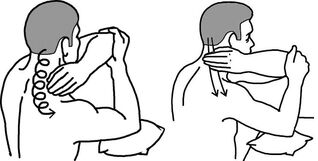
Exercise therapy, physiotherapy and cervical collar massage are performed in the complex for several weeks.
Massage options:
- dotted;
- self-massage;
- vacuum;
- classic.
Needle Applicator
One of the possibilities for reflexology using a special plate. It is based on mechanical action on the innervation zones.
You can buy this device in specialized pharmacies and use it as a massager on your own.
Rubbing from pharmaceutical products
There are currently a large number of pharmaceutical infusions and lotions, which eliminates the need for self-preparation.
These grits include the following elements:
- Essential oils (sage, mint, lemon balm, aloe, tea tree).
- Analgesics for pain relief.
- Irritant (pepper, mustard).
- Antiseptic (alcohol, menthol).
Apply each according to the instructions provided.
Folk remedies and recipes
Recipes of folk remedies in the treatment of cervical osteochondrosis have long been known for their effectiveness and simplicity. How and how to treat cervical osteochondrosis at home - these are the best known and most effective methods of traditional medicine used in patients with pathology of the musculoskeletal system, especially osteochondrosis of the cervical spine.

Herbal Infusions
Herbs in the treatment of osteochondrosis at home are the most popular among the population. Medications are available at any pharmacy in the city.
The application does not cause significant consequences and repeated treatments with a small interruption are possible. Age restrictions are also conditional (admission is allowed for children in the absence of contraindications).
You should know that not all infusions, lotions and compresses are recommended to be used hot. The reason is that heating of the affected area can cause diffuse purulent infection (phlegmon, abscess), especially if there was micro damage in this area. Hot substances have a negative effect on people with hypertension associated with osteochondrosis.
Sunflower decoction
This treatment option uses the root of this plant (you can prepare it yourself or buy it in pharmacies).
Pour 1 cup of boiling water over the root or 2 teaspoons of dry matter. Insist for 24 hours, then moisten the gauze and apply to the collar area. The course of treatment is 7 days.
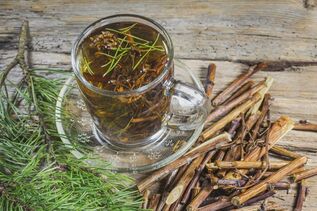
Softwood soup
Needles have pronounced tanning properties. There are several ways to apply this:
- In strengthening baths. Pour a few liters of boiling water over a few pine legs and leave for 2 hours. Then pour the resulting solution into the bath at a temperature of 38 ° C. The duration of the bath is 30 minutes. Course 7 days.
- In infusions. Pour 2 teaspoons of dry matter with 70% alcohol solution and leave for 3 days. Rub the affected area 2 times a day. The deadline is 14 days.
- Cook the pine legs for 5 minutes. Strain the resulting broth and rub for 20 minutes.
Dandelion soup
Has mild anti-inflammatory properties. Improves metabolic processes in tissues. Usage cases:
- Take 2-3 teaspoons of dry matter and pour boiling water (300 ml). Insist for an hour and rub into the area of the cervix until a slight redness appears. Course 7 days.
- Pour 3 teaspoons of dandelion flowers and chamomile (1: 1) with 70% alcohol solution. Insist 24 hours, then apply 2 times a day.
Infusion of pine buds
Method of preparation: pour 2-3 tablespoons of kidneys with boiling water and after complete cooling use on the affected area. Course 8 days.

Compressions and Applications
Treatment of cervical osteochondrosis by folk methods includes multiple dressings and lotions, but you must use a few basic rules when using:
- Frequent recurrences of treatment (usually 2-3). The reason is that the efficiency of therapy in one course is extremely low.
- The effect of the treatment is more pronounced if you wrap a scarf / towel around the damaged area. The reason is the additional thermal effect in addition to the action of drugs.
With kerosene
Kerosene 50 ml, mix with 2-3 teaspoons of sunflower oil and 1-2 teaspoons of baking soda. Rub the resulting mixture into the collar area for 20 minutes. The course of therapy is 15 days.
The mixture is irritating and must be used with caution.
Potatoes
Wraps, infusions and lotions and potatoes are the most common treatments. There are several reasons for this:
- availability;
- efficiency;
- lack of strict contraindications (with the exception of starch allergy).
Usage examples:
- Finely grate the potatoes and strain. Form the resulting dry mixture into a cake and apply on the affected area for 20 minutes. The course of therapy is 2 weeks.
- Cook the potatoes (3-4) in their skins. Then crush and wrap in gauze. Apply warm potatoes to the collar area for 20 minutes (avoid creating burns). The course of therapy is 7 days.
With radish
Radish is irritating, so exposure time should be reduced according to individual tolerance.
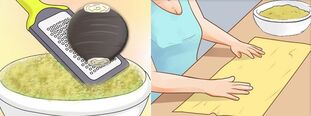
Examples of radish use:
- Grate the radish on a fine grater and strain through a sieve. Apply the resulting dry mixture on the cervical spine for 10-20 minutes. The course of therapy is 2 weeks.
- Grate the radish and strain. Mix the resulting juice with honey in a ratio of 1: 3. Pour alcohol over the solution and leave in a dark room for 3 days. Then moisten the gauze with the infusion and apply for 10-20 minutes on the affected area. The course of therapy is 7 days.
Sour cream and comfrey
Comfrey has a strong astringent and anti-inflammatory effect. The root of the plant is rubbed on a fine grater and mixed with sour cream until a paste is obtained (usually in a ratio of 1: 1). In the cervical area 2 minutes and a course of 7 days.
Honey recipes
Honey has an almost immeasurable list of useful properties:
- anti-inflammatory;
- antiseptic;
- tanning;
- regenerates.
The only contraindications are allergic reactions or individual intolerance.
Most popular honey recipes:
- Pure honey. Rub honey (50-100 g) into the affected area for 20 minutes. The course of therapy is 15 days.
- Mix 50 g of honey and 2 teaspoons of mustard and rub the creamy mixture into the neck for 20-30 minutes. The course of therapy is 2 weeks.
- Mix honey (20–40 mg), aloe juice (5 ml) and tea tree oil (2–4 drops). Stir well and apply for 20 minutes. The course of therapy is 9 days.
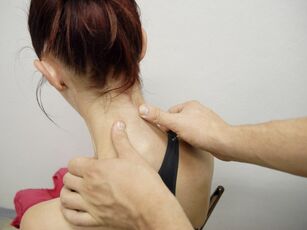
Rubbing
Treatment of cervical osteochondrosis is possible at home by rubbing the infected area with infusions and decoctions.
This method is based on two mechanisms:
- mechanical pressure;
- medicinal effect of medicinal herbs.
Mother and stepmother
Flowers and plant stems can be used in the preparation of the infusion. When cooking, pour 70% alcohol and leave for 4 weeks in a dark room. After that, strain the solution through gauze and keep in a glass container out of reach of children.
Method of application: rub into the affected area twice a day for 10-15 minutes with light massage movements. The course of therapy is 2 weeks.
Horseradish and elderberry
Horseradish and elderberry can be used separately or in combination. The combined treatment is presented below.
Preparation: pour boiling water (1 cup) of horseradish and elderberry leaves (with leaves) separately from each other. Insist throughout the day. Then strain both solutions and mix in a ratio of 1: 1. Rub the cervical spine and the adjacent area once a day for 10 minutes. The course of therapy is 7 days.
Fat
Forms of ointment medications quickly relieve pain in cervical osteochondrosis.
Efficacy is reduced if only this form of treatment is used.
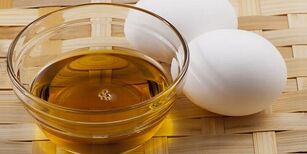
Egg in butter
Mix the egg whites (2-3) with the butter in a ratio of 1: 2 until a creamy paste is obtained. Apply to the joint area once a day for 30 minutes and wrap with a terry towel.
Ginger ointment
Has a pronounced anti-inflammatory effect. There are several ways to use ginger:
- Pour 2-3 roots of plants with olive oil and leave for 24 hours. Lubricate the neck with the resulting mixture once a day at night. The course of therapy is 2 weeks.
- Grind the ginger root, add the nutmeg and linseed oil. Cover the resulting porridge mixture with a towel and leave in a dark room for 8 hours. Rub into the wrist for 20 minutes for 7 days.
Egg and mustard
Egg whites are rich in protein, and mustard has a pronounced irritant effect (enhances local microcirculation) - these are the main reasons for the use of these components in the treatment of osteochondrosis.
Preparation: mix 2 egg white and 1-1, 5 tablespoons. l. spoons of mustard until creamy. Apply to the affected area for 10-15 minutes. Course 7 days.
Mustard can cause severe local tissue irritation. In case of intense pain syndrome, the procedure is not recommended.
Warming with ozokerite
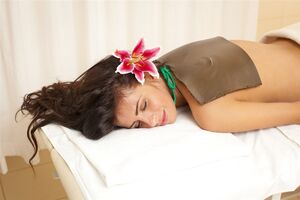
Ozokerite is a naturally occurring wax. This procedure is often performed in sanatoriums with paraffin heat treatment.
Expressed effects:
- painkiller;
- spasmolytic;
- anti-inflammatory;
- regenerative.
Method of application: the wax is heated in a special container until it becomes liquid. It is then carefully poured into a bowl with sides (a baking sheet can be used) and allowed to cool to a temperature of 50 C. The resulting mass is then separated from the pan and applied to the affected area for local heating of the tissue.
Carefully monitor the temperature of the wax and avoid burns.
Prevent deterioration
Recommendations for the treatment of cervical osteochondrosis are generally known, as they are applicable to all rheumatic diseases.
To effectively prevent the development of the disease, it is recommended to follow a few simple but useful tips:
- physical activity (moderate);
- healthy diet (moderate salt intake);
- properly fitted shoes (appropriate size, heel 4-6 cm, cushion insoles).
Adherence to these rules is a guarantee of spine health!
















